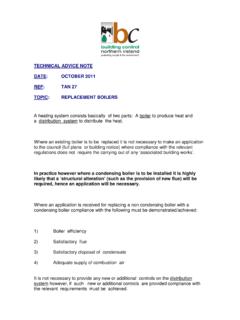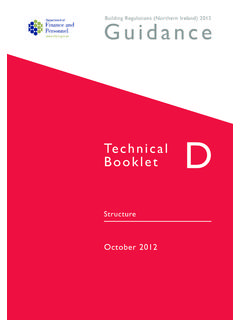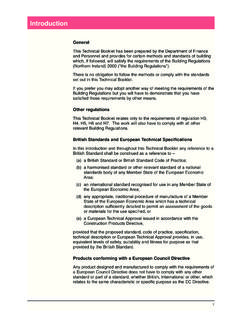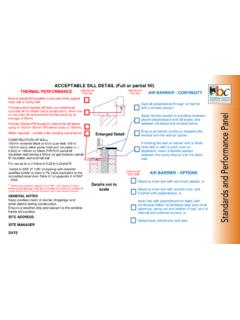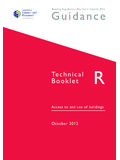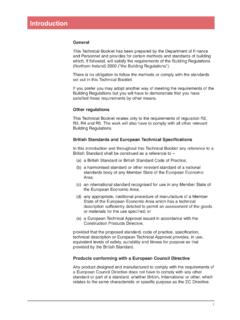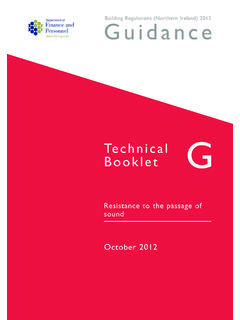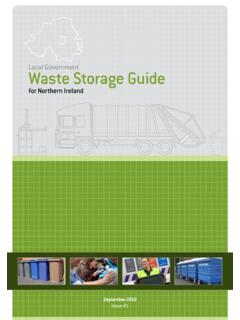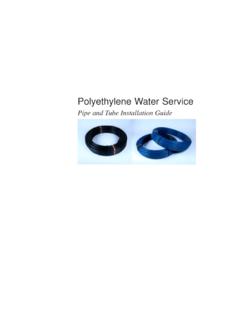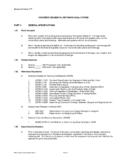Transcription of Introduction - Building Control NI
1 1 GeneralThis Technical Booklet has been prepared bythe Department of the Environment forNorthern Ireland and provides for certainmethods and standards of Building which, iffollowed, will satisfy the requirements of theBuilding Regulations (Northern Ireland) 1990( the Building Regulations ).There is no obligation to follow the methods orcomply with the standards set out in thisTechnical you prefer you may adopt another way ofmeeting the requirements of the BuildingRegulations but you will have to demonstratethat you have satisfied those requirements byother regulationsThis Technical Booklet relates only to therequirements of Regulations N3, N5 and work will also have to comply with all otherrelevant Building Standards and EuropeanTechnical SpecificationsIn this Introduction and throughout thisTechnical Booklet any reference to a BritishStandard shall be construed as a referenceto a.
2 (a) British Standard or a British Standard Codeof Practice, or(b) national technical specification, of aMember State of the European Community,which provides an equivalent standard ofprotection or and workmanshipAny work to which a requirement of theBuilding Regulations applies must, inaccordance with Part B of the BuildingRegulations, be carried out with suitablematerials and in a workmanlike manner. Youcan comply with the requirements of Part B byfollowing an appropriate British Standard oryou may demonstrate that you have compliedwith those requirements by other suitablemeans, such as an acceptable British Board ofAgr ment Certificate, Quality AssuranceScheme, Independent Certification Scheme orAccredited Laboratory Test diagrams in this Technical Bookletsupplement the text.
3 They do not show all thedetails of construction and are not intended toillustrate compliance with any otherrequirement of the Building Regulations. Theyare not necessarily to scale and should not beused as working reference in this Technical Booklet to apublication shall, unless otherwise stated, beconstrued as a reference to the edition quoted,together with any amendments, supplementsor addenda thereto current at 31st 1 Sanitary Pipework2 Section 2 Underground Foul Drainage7 Section 3 Rain-water Drainage13 Contents2 Materials for pipes, fittings and materials for sanitary pipework shallbe in accordance with the relevant BritishStandard given in Table 1. Where differentmetals are used they shall be separated bynon-metallic material to prevent electrolyticcorrosion.
4 Pipes shall be firmly supportedwithout restricting thermal of capacity of a sanitary pipeworksystem shall be adequate to carry theexpected flow at any point, provided that wherea minimum size of pipe is stated in aparagraph, Table or Diagram that size of pipeshall be expected flow dependson the type, number and grouping ofappliances and the flow rates given in Table 2shall be seals (traps) points of discharge into a system shallbe fitted with a water seal (trap) to prevent airfrom the system entering the Building . Theminimum size of trap and depth of seal for anappliance shall be as given in Table system shall be capable ofwithstanding an air or smoke test of a positivepressure of 38 mm on a water gauge for atleast 3 minutes, and every trap shall maintain awater seal of at least 25 for cleaning blockages in a trap forms part of an appliance theappliance shall be removable.
5 All other trapsshall be fitted directly after the appliance andshall be removable or be fitted with a prevent the water seal from beingbroken by the pressures which may develop inthe system a branch pipe shall either beventilated as described in paragraph orconstructed as described in paragraph StandardPipes:cast ironBS 416: 1973copperBS 864: Part 2: 1983,BS 2871: Part 1: 1971galvanised steelBS 3868: 1973 (1980)uPVCBS 4514: 1983polypropyleneBS 5254: 1976other plasticBS 5255: 1976 Traps:plasticBS 3943: 1979 (1988)ApplianceFlow rate(litres/sec)wc (9 litre cistern) tap washing (per person unit) ofDepth oftrap(mm)seal (mm)washbasinbidet3275*sinkbathshower407 5*food waste disposal uniturinal bowlwc7550sanitary towel macerator4075food waste disposal unit(industrial type)5075urinal (1 to 6 person units)
6 6550*May be reduced to 40 mm for a washbasin, sink, bath orshower located on the ground floor and discharging into anexternal 1 Sanitary pipeworkTable 1 Materials for sanitary pipeworkTable2 Flow rates from appliancesTable 3 Minimum trap sizes and seal depths3 Overflow an overflow pipe discharges to abranch pipe or a stack it shall do so through atrap. In all other cases an overflow pipe shalldischarge in a visible location and shall notcause dampness in, or damage to, any part ofa branch pipe shall be at least the samediameter as the appliance trap and where itserves more than one appliance and isunvented, it shall be of at least the diameterand gradient given in Table 4.
7 A bend in abranch pipe shall have as large a radius aspossible and never be less than 75 mm centreline radius. A junction on a branch pipe shall be made either at 45 or with a minimumsweep of 25 mm radius. The connection of abranch pipe of 75 mm or more in diameter to astack shall be made either at 45 or with aminimum sweep of 50 mm branch pipe shall discharge into a stack: (i) in a way which prevents cross-flow intoanother branch pipe (see Diagram 1), and(ii) not less than the relevant height,above the invert level at the foot of thestack, given in Diagram branch pipe from an appliance on a storeyabove the ground storey shall discharge intoanother branch pipe or a discharge stack.
8 Anappliance on the ground storey maydischarge into another branch pipe or adischarge stack, a stub stack, a drain or (if theappliance is for washing purposes only) a gullyprovided that: Table4 Common branch discharge pipes (unvented)Max number to beMax length ofMin size of pipeGradient limits (fall per metre)ApplianceconnectedORbranch (m)(mm)min (mm)max (mm)wc s8151009to90urinals: bowls5*5018to90stalls6*6518to90washbasin s44 (no bends)5018to45*No limitations as regards venting but should be as short as possibleDiagram 1 Branch connections to stackssmaller similar sized opposedbranches not directly oppositeshall be offset by: 110mm on 100mm diameterstack250 mm on 150mm diameterstacka 50mm diameter parallelbranch shall be used where abranch pipe would enter thestack within 200mm below connection50mm (min) sweep50mmparallelbranch Detail at AB Detail at BHeight of buildinghouses up to 3 storeysany Building up to 5 storeysany Building up to 20 storeysany Building over 20 storeysH450mm750mm1 storey2 storeys800mm (min)centre lineradius*lowestconnectiona branch pipe may enter the stackat the same level as a if the connections areat right anglesRadius may be reduced to200mm for houses up to3 storeysAlternate detail at BMinimum height (H) A * 4(a)
9 A branch pipe from a water closet shalldischarge directly to a drain only if the dropis less than m (see Diagram 2); and(b) a branch pipe shall discharge to a gullyonly between the grating and the top levelof the water for clearing blockages in points shall be provided to giveaccess to any length of branch pipe whichcannot be reached by removing a ventilating to paragraph a branchventilating pipe shall be connected to a branchpipe within 300 mm of the trap (see Diagram 4)and shall be not less than 25 mm diameter or,where the length of the ventilating pipeexceeds 15 m or has more than 5 bends, notless than 32 mm diameter. A branch ventilatingpipe shall: (a) terminate in the external air at least 900mm above any opening into a buildingwithin 3 m, with a cage or cover which doesnot restrict the air flow (see Diagram 3);(b) connect to a ventilated discharge stackabove the spillover level of the highestappliance served (see Diagram 4); or(c) connect to a ventilating stack (seeparagraph ).
10 Unventilated branch branch ventilating pipe shall not berequired if the length and slope of a branchpipe does not exceed the maximumdimensions and gradients for the relevant pipediameters given in Diagram ventilation stack shall provideventilation to branch ventilation pipes and mayalso provide ventilation to underground fouldrainage (see paragraph ). The lower end ofa ventilation stack may be connected to aventilated discharge stack below the lowestbranch pipe connection. The upper end of aventilation stack shall: (a) terminate in the external air at least 900mm above any opening into a buildingwithin 3 m, with a cage or cover whichdoes not restrict the air flow (seeDiagram 3).
